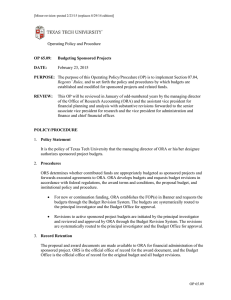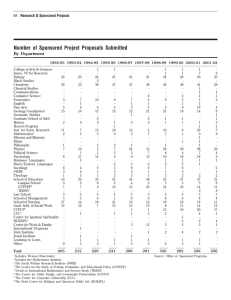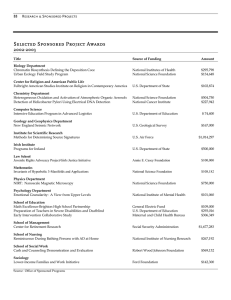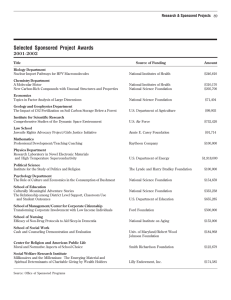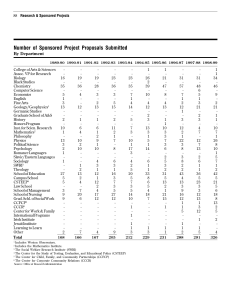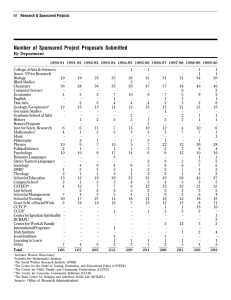Office of Research Administration Graduate School and Research Administrative Program Review
advertisement
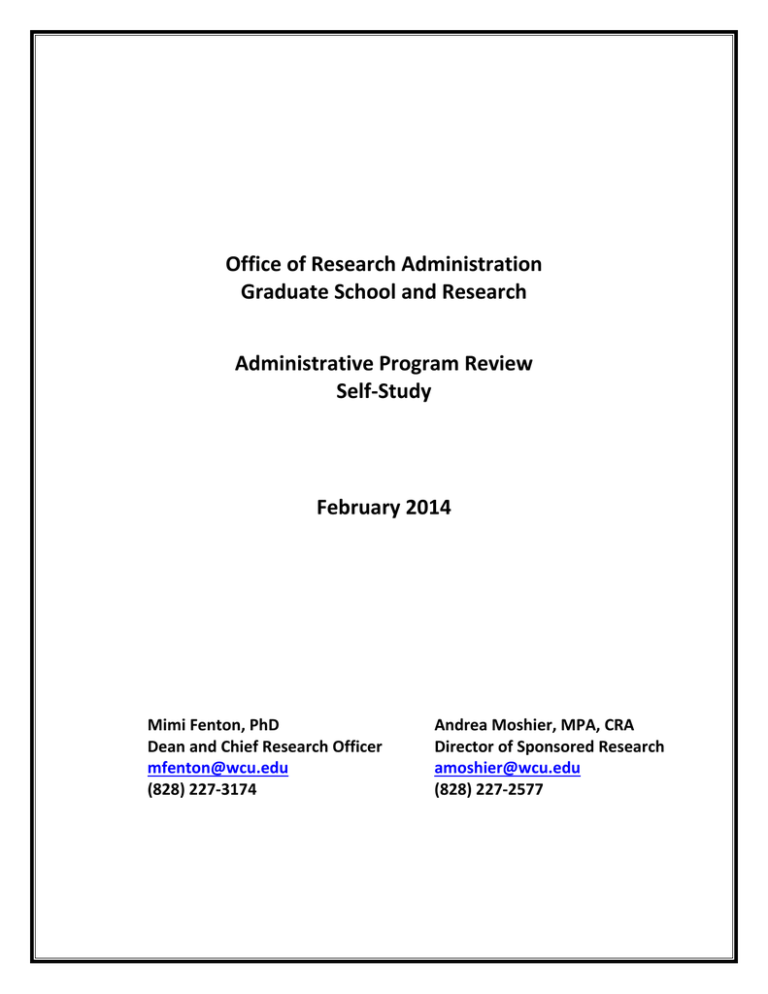
Office of Research Administration Graduate School and Research Administrative Program Review Self‐Study February 2014 Mimi Fenton, PhD Dean and Chief Research Officer mfenton@wcu.edu (828) 227‐3174 Andrea Moshier, MPA, CRA Director of Sponsored Research amoshier@wcu.edu (828) 227‐2577 EXECUTIVE SUMMARY OFFICE OF RESEARCH ADMINISTRATION HISTORY AND DESCRIPTION OF UNIT: The primary purpose of the unit is to provide high‐quality service in the development and administration of sponsored research activities and to protect the fiscal and legal integrity of the institution. The unit currently has a staff of 3.25, which includes the Director of Sponsored Research/Compliance Office, Grants Services Coordinator, Research Administrator/eRA Manager, and Faculty Services Coordinator (.25 position from Coulter Faculty Commons). The unit is administered by the Dean of the Graduate School and Research, who also serves as Chief Research Officer (CRO). The key priorities of the unit are to build and stabilize a strong infrastructure to support grant activity, transform the culture and identity of sponsored research and the Office of Research Administration (ORA) on campus, and increase faculty/staff engagement with sponsored research resulting in the significant increase in proposals and awards. For the last two decades, the unit has been largely perceived as incompetent, ineffectual, misguided, and obstructionist. While the unit struggles with this historical reputation, it is in the midst of a positive transformation in personnel, mission, and operations. It is a time of significant transition. ALIGNMENT WITH WCU MISSION, VISION, AND VALUES: The ORA aligns with the university’s 20/20 Strategic Goals: 4.4.2: 4.4.3, 6.3.7 which aim to provide more support and infrastructure of research and scholarship, and to significantly increase grants and contracts activities at the university. ORA aligns with the QEP by partnering with faculty seeking external resources to support intentional, integrated, synthetic learning opportunities for our students. The ORA aligns with UNC‐Tomorrow in its mission to increase activities that will help transform the economic development of NC communities and also apply, translate, and communicate research to broader audiences. The purpose of the unit has shifted in the past two years to a more customer‐service oriented model that strives to minimize bureaucracy and provide support to faculty and staff while also ensuring compliance with state and federal regulations. This is already resulting in more positive and productive interactions with faculty, and grants submissions and awards have increased measurably. Over the next 5 years, we do not expect the purpose of the office to change, but to expand to include additional services and programs that are not currently available due to limited staffing and funding. As the research portfolio of the university grows, the office staff will need to grow in kind not only to meet the needs of faculty, but to assure managerial, administrative efficiencies, and regulatory compliance. DEMAND FOR THE PROGRAM: Three populations of faculty/staff engage with the ORA: novice, intermediate, and experienced researchers. Each population has different needs. Demand for the unit’s programs and services can be measured by the number of proposals submitted, registration for special initiatives, number of requested meetings/consultations with ORA staff, and number of compliance protocol submitted. The ORA provides a wholistic sponsored program support by helping faculty develop their research agenda, finding funding opportunities, reviewing funding agency and foundation guidelines, developing proposal components, editing proposal content, reviewing and approving proposals, managing the electronic grant submission system (RAMSeS), negotiating awards and contracts, accepting and processing awards and contracts, and passing the award to the Director of Grants and Contracts in the Controller’s Office. The unit has the potential to make a significant positive impact on the academic mission of the university. QUALITY: The ORA has measured quality of programs and services through qualitative and quantitative analysis. Historical evidence indicates a distinct lack of quality. During spring 2013, the ORA proactively addressed evaluations and made significant personnel changes, structural and infrastructural modifications, implemented a short‐term and long‐term Strategic Plan, established a Research Advisory Board, and a Sponsored Research Council. Grants activities to date show a strong positive response to the changes. Submissions have increased by 36%, and award amounts at mid‐year exceed last year’s total by more than $1,000,000. The ORA will require increased resources and staff to sustain the quality of services we offer as activities increase. COST EFFECTIVENESS: The ORA operates on a shoe‐string budget of $270,500 for salaries and operating expenses: $205,000 from state funds, $66,500 from the Chancellor’s allocation of Indirect Costs (IDCs) to the unit. The unit does not directly receive any portion of IDCs to support initiatives to foster and support research. OPPORTUNITY ANALYSIS: The unit continues to struggle in some sectors from its historical reputation, but it is undergoing a significant positive shift, with positive outcomes, with researchers across campus, with other units, and with administrators. Continued progress toward implementing the unit’s Strategic Plan will facilitate and assure the continued change. Continued hiring of staff who possess not only strong technical skills, but strong understanding of and support for faculty, and strong team‐work skills will be crucial to the unit for sustaining the change in the mission and core values of the unit. The scope of the unit’s activities will increase, and thus increased resources and staff to support the level, breadth, and quality of services offered are necessary. Continuing professional development for all staff members and leaders is crucial, and continued support and advocacy for sponsored activities from the administration and from faculty will be vital for taking the research enterprise at WCU to the next level. Office of Research Administration Self‐Study History and description of unit 1. State the primary purpose and key functions of the unit. The Office of Research Administration (ORA) supports the university’s academic mission to improve individual lives and enhance economic and community development through academic programs, educational outreach, research, and creative and cultural activities. We accomplish this by adhering to the unit’s Core Values in all ORA activities and interactions with internal and external constituents. • Provide high-quality service in the development and administration of sponsored research activities • Integrate research into the university’s intellectual and academic culture and identity • Protect the fiscal and legal integrity of the institution • Increase faculty/staff engagement with sponsored research resulting in the significant increase in proposals and awards • Cultivate research experiences and opportunities for graduate and undergraduate students 2. List the top 3-5 goals/priorities of the unit. 1: Build and stabilize a strong, faculty-focused ORA infrastructure to support WCU faculty and staff in seeking and managing sponsored research activities and programs. This infrastructure must simultaneously assure individual and institutional regulatory compliance and integrity, and provide support and advocacy for faculty needs and aspirations. 2: Transform the culture and identity of sponsored research at WCU. Our goal is for ORA to partner with faculty and staff, so that the research enterprise is more cohesively integrated into the intellectual, academic, social, and financial value system of the university. The goal and hopeful outcome of this environment will be more faculty research activities. 3: Increase sponsored research activities by 100%, applications by 50%, and awards by 25%, as directed by the university’s 20/20 Strategic Plan: Initiative 6.3.7. 3. Summarize the history of this unit on campus. For the last two decades, the unit has been largely perceived as incompetent, ineffectual, misguided, and obstructionist. The ORA has been fraught with instability internally because of personnel issues and attrition: since 1998, there have been 3 different deans whose dominant focus and efforts were in the Graduate School and not the ORA, and 4 different Directors of Sponsored Research who were incapable of relating to faculty and their needs. (See 2009 & 2011 COACHE survey and 2011 Radhakrishnan report). In the past two years, significant leadership and personnel changes were made, and the unit is in the midst of transition, but is beginning to stabilize internally with positive outcomes externally. The current dean, Dr. Mimi Fenton, restructured the office from a hierarchical, vertical organization, to a horizontal, team-based, cross-trained unit. Two former staff were replaced with new staff who have not only strong technical skills, but value and respect faculty, can work collegially and supportively with faculty, understand the role and challenges of research at a PUI, and believe in teamwork and the efficacy of customer service. The interim Director of Sponsored Research, Andrea Moshier (CRA), was recently selected after a rigorous national search to serve permanently in the role beginning February 1, and her selection was in part due to her strong track-record of building positive and effective relationships with faculty in her role as Compliance Officer (April 2012-present), and her effective leadership as Interim Director (April 2013-January 2014). A search is ongoing for a new Research Protections Officer, and should be completed by March 15. A request is being put forth in the 2014-2015 Budget Hearings for a Proposal Developer to help faculty with grant writing, identifying funding opportunities, and revising unfunded proposals for resubmission. This has been identified by faculty as the most exigent need. A request is also being made for an Administrative Assistant as the unit currently does not have one exclusively dedicated to its needs—which are increasing as research activities increase. Significant and steady progress is being made on implementing the Strategic Plan to enact responses to previous evaluations of the unit. 4. Describe the structure of the unit and how it is situated organizationally within the institution. The Office of Research Administration is part of Graduate School and Research which is a unit under Academic Affairs Division. It is administered by the Dean of the Graduate School and Research who also serves as Chief Research Officer. The office has four full-time staff positions and one split-time staff that is .25 FTE in ORA. The current team includes the CRO, Director of Sponsored Research, Protections/Compliance Officer (search in-progress), Grants Services Coordinator, Research Adminstrator/eRA manager, and Faculty Services Coordinator (.25 position from the Coulter Faculty Commons). 5. Provide an organizational chart of the unit with every employee identified by title and name. Attach a brief (3-4 bullets) list of primary duties carried out by each employee on the chart. Also, for each full-time staff member provide a full curriculum vitae or 2-page vitae/resume summary. Organizational Chart: See Appendix A Roles and Responsibilities: See Appendix B Curriculum Vitae: See Appendix C 6. If applicable, describe the number and contribution of student employees or graduate assistants to the unit’s program and services. The office of research employs one Graduate Assistant, 20 hours per week, to provide administrative support. Historically, this position has primarily served the IRB protocol processing by conducting preliminary review and processing. There is an effort to broaden the responsibilities of this position to enhance the educational experience for the student. This position is becoming more involved in special initiatives such as interviewing/writing the research spotlight for the website and assisting with reporting needs. Alignment with WCU Mission, Vision, Values 1. How does the unit mission align with the university mission with specific reference to support the QEP, UNC Tomorrow and academic colleges/schools? The ORA aligns with the university’s 20/20 Strategic Goals in the following ways: 4.4.2: Ensure appropriate institutional infrastructure to support scholarship and research; 4.4.3: Increase support for scholarship; and 6.3.7: Develop infrastructure for research and sponsored programs, technology transfer…and increase research grant and contract applications by 100%, grants and contracts received by 50% and total annual amount of awards received by 25%.The ORA aligns with the university’s QEP goal of synthesized, engaged, and intentional learning, by partnering with faculty and staff who seek grants and external support for programing opportunities that “empower students to integrate knowledge and skills from their academic and co-curricular experiences to become intentional participants in their own learning.” The ORA aligns with UNC TOMORROW in the following ways: The unit can partner with faculty to seek, manage, and support external funding for program development to meets the UNC goals of educating “its students to be personally and professionally successful in the 21st century and, to do so, should enhance the global competitiveness of its institutions and their graduates.” Further, sponsored research activities support the UNC Tomorrow Goal 4.4. of transforming the economic development of NC Communities, and 4.7 to “apply, translate, and communicate research and scholarship to broader audiences.” 2. How has the purpose of unit changed in the past 5 years? The purpose of the unit has shifted in the last two years toward a more customer-service oriented model that strives to minimize bureaucracy and provide support to faculty and staff while also ensuring compliance with state and federal regulations. Without a doubt, the unit is in a state of transition, transformation, and growth in a positive direction. Further, the role of research in general at the university has been changing for the following key reasons: the influx of new faculty hires with experience in and goals in sponsored research; The Boyer Model has broadened the definition of scholarship to be more inclusive; faculty are engaged in and committed to a now robust undergraduate research culture. As state funding for faculty salaries and academic programs has declined, the revenue generated from external, sponsored research has received more attention from the administration as a possible way to enable faculty and the university to better accomplish its academic mission and aspirations. Further, a faculty-led initiative resulted in the momentous change in the IDC distribution model to benefit Principal Investigators (PIs), departments, and colleges financially and this has had a positive and productive impact. 3. How do you expect the purpose to change in the next 5 years? Over the next 5 years, we do not expect the purpose of the office to change, but to expand to include additional services and programs that are not currently available due to limited staffing. As the research portfolio of the university grows, the office will also need to grow to meet the needs and assure managerial, administrative efficiencies and compliance. Demand for the program 1. Who are the key users/participants of the unit’s programs or services? There are three populations of faculty/staff that engage with the Office of Research: Novice Researchers, Intermediate Researchers, and Experienced Researchers. Novice researchers have little to no experience with sponsored programs and need a lot of support in proposal development. Intermediate researchers have written grant proposals before but may not have been successful. These researchers need support to make their proposals more competitive so they can become successfully funded. They have a basic understanding of what sponsored research is, but need more mentoring and coaching. Experienced researchers have portfolios of funded research and need help identifying new sources of funding or collaboration. They may require less support in proposal development but need advocacy for additional post-award management support. 2. How do you identify and measure demand for the unit’s program or services? Demand for the unit’s programs and services can be measured by the number of proposals submitted, registration for special initiatives (like STARS), number of requested meetings, and number of compliance protocol submitted. 3. List those other units on campus that interact most with this unit. Briefly describe the nature of those interactions. • Office of Development- sometimes we have to determine if an award is a gift or grant through consultation with Development • Administration and Finance- Post-Award administration is under the Administration and Finance unit so there is frequent interaction between ORA staff and the Director of Grants and Contracts in the Controller’s Office. • Academic Affairs- Faculty and staff use ORA services when preparing and submitting proposals for sponsored research and for submitting research compliance protocols. • Human Resources- Assisting faculty with personnel decisions related to sponsored programs • International Programs and Services- Assisting PIs with foreign collaborators, travel, and other services • Coulter Faculty Commons- Assisting faculty with pedagogy and scholarship design related to sponsored programs or evaluation. Also, Lee Crayton is .75 FTE at CFC and .25 FTE at ORA. • Facilities Management- Office of Safety works with the Compliance Officer to ensure safety and compliance with biohazards 4. List other units on campus that provide related programs and services. • Office of Development • Executive Director of the Millennial Initiative • Director of Federal Relations • Coulter Faculty Commons • Controller’s Office 5. Describe the unique contributions of this unit. The Office of Research Administration provides a holistic sponsored program support by helping faculty develop their research agenda, finding funding opportunities, reviewing funding agency and foundation guidelines, developing proposal components, editing proposal content, reviewing and approving proposals, managing the electronic grant submission system (RAMSeS), negotiating awards and contracts, accepting and processing awards and contracts, and passing the award to the Director of Grants and Contracts in the Controller’s Office. The unit has the potential to make a significant positive impact on the academic mission of the university. Quality 1. How do you identify and measure quality of the unit’s programs or services? List the top benchmarks used to assess quality? ORA has measured quality of programs are services through qualitative and quantitative analysis. • Quality of approved proposals can be measured by the rate of success (how many proposed projects were awarded). • Quality of services provided can be measured through the number of proposed projects since more proposals will be submitted if the office is perceived to be efficient and service oriented. • Quality of the STARS program can be measured by the number and amount of proposed projects after the program has ended, number of those projects that are funded, and through qualitative surveys. • An external evaluator was hired to do an evaluation of the ORA office structure, efficiency, and effectiveness in 2011. A copy of this report is in the appendices. • Quality of services provided can be measured qualitatively through email correspondence, informal surveys, anecdotes, and feedback from the Sponsored Research Council. 2. How do you use the results of quality assessments to improve programs and/or services? Provide specific examples. During spring 2013, the ORA reflectively and proactively addressed the COACHE survey data and comments, as well as the Radhakrishnan report, item by item. The team together wrote a short-term Strategic Plan to address the negative interactions and reputation of the unit, and to guide changes to daily operations, messaging, and policies. In summer 2013, an Ad-Hoc Research Advisory Board comprised of key PIs was established to guide, advise, provide counsel on the desired and ongoing changes. This Board met regularly for 3 months, and provided constant feedback on the long-term Strategic Plan for the unit. In October 2013, a Sponsored Research Council was established. This body now meets monthly to consider and vote on newly established SOPs, and to serve as active advocates for and advisors for the unit. The office plans to devise a “Satisfaction Survey” to distribute to each PI a few days after proposal submission. This feedback will be gathered, reviewed, and addressed within the unity with the goal of constant improvement in services provided. Employee performance reviews also serve as means to recognize areas of strength and needed growth/development. 3. What were the major accomplishments of the unit in the past five years? Include those directly related to unit functions AND/OR other contribution related to University goals. • In 2012, ORA hired its first Research Compliance Officer. This position is responsible for IRB, IACUC, IBC, COI, RCR and Export Control. • In fall 2013, special initiatives were established to engage the campus community: STARS, First Fridays, Grants Writer’s Reception. • Implementation of RAMSeS which allows for more efficient processing of proposals, improved record keeping, and increased reporting capabilities. Cost Effectiveness 1. How do you identify and measure cost effectiveness of this unit? List the top benchmarks used to assess cost effectiveness. The Office of Research Administration currently operates on a minimal budget. This has left little to no opportunity to assess cost effectiveness. Should the ORA benefit from an increased budget which allows opportunity to engage in a broader scope of activities such as external speaker series, incentive/seed funding or faculty, or the publication of a research journal, the ORA would put measures in place to ensure a return on investment. 2. Attach an itemized spreadsheet (see template) outlining ALL revenues/resources generated and expenses incurred (including salaries) for the unit for the past 3 years. See Appendix D Opportunity Analysis 1. How can programs or services offered by the unit be enhanced? Examples might include: o Automation of processes i. Implementation of IRBIS (Human Subjects Research applications), ACAP (animal care and use applications), AIR (documentation of activities, interests, and relationships) o Collaboration with other units on campus i. Increased collaboration with the office of safety and risk management compliance ii. Increased collaboration with Human Resources iii. Increased collaborations with the Office of Development – funding opportunities for faculty and staff iv. Increased collaborations with Coulter Faculty Commons – for expertise to lend at the proposal development stage o Outsourcing to an independent contractor i. Grants writers ii. Specialized trainers 2. How do the activities of other units advance or hinder the effectiveness of your unit? Focus should be on those units that were identified in item #3 in the section on “Demand for the Program”. • Office of Development- Development officers establish and foster relationships with potential donors to the university. Sometimes funds are awarded to the university and it isn’t clear if it is a gift or a grant. Gifts go through development and grants come through ORA. Both of our offices work to bring external funding into the university, but in different capacities so I would say our services complement each other. • Executive Director of Millennial Initiatives (EDMI)- The EDMI will work to bring industry and corporate interests to partner with university academic interests to better serve students and the community. This position could advance the effectiveness of our unit by identifying potential research collaborations between corporations and faculty research agendas. • Director of Federal Relations (DFR) - The DFR can advance the effectiveness of our unit by understanding the climate of federal funding and identifying areas of potential growth within the federal funding environment. • Coulter Faculty Commons (CFC)- The CFC assists faculty with development of scholarship and curriculum. We share 1 FTE with this unit to assist with funding searches and project concept development. There are other opportunities for shared resources through co-sponsored training opportunities and faculty development workshops. • Controller’s Office- The Director of Grants and Contracts in the Controller’s office is responsible for managing all sponsored programs after they have been awarded. This is the only position related to that function. If the number and amount of sponsored programs increases it could place an unreasonable and unmanageable workload upon this position which would hinder the effectiveness of our office. Although we are separate units we are seen as proving a continuity of service. There is very little college or department level administrate support for grant management which also puts extra burden on the DGC to provide grants management support to faculty. If the DGC is unable to provide enough service to faculty they will less inclined to pursue external funding which impacts our strategic plan of increasing sponsored research. 3. What programs and services offered by the unit are redundant or outside the scope of the unit’s primary purpose? The office does not provide redundant services or service outside the scope of our purpose. 4. What are similar units at peer or aspirant institutions doing that this unit would like to do or should be doing? • Stronger proposal development support • Increased use of metrics and measures. 5. What additional cost-savings could be achieved in this unit? None. This unit operates on minimal budget and will soon be understaffed as research activities increase. Without adequate staff, the unit will not be capable of offering the level of services needed to sustain the desired level of activity. 6. What external funding opportunities (grants, contracts, etc.) exist that could be pursued by this unit? If applicable, describe any efforts to pursue such funding to date? It is entirely appropriate for the unit to receive a portion of IDCs. Discussions with the Provost on this topic occur on a regular basis. 7. What would it take to make the program exemplary? • Continued and sustained financial resources and staffing as needs emerge with increased grants activities. • Work plan and resources to support continuing professional development for each staff member in order to ensure currency of knowledge and skills, and to increase our networking and visibility in the PUI community. • As the internal functions of the unit stabilizes, the Dean/CRO needs to be able to expand internal relationships with WCU researchers and external relationships with funding agencies and community partners in order to identify, foster, and strategically lead the research enterprise. • Continued self-awareness and the willingness to embrace an ethic of constant improvement and proactive engagement with the university community to assure we are responding to their needs in ways that will help them succeed. • Awareness, support, and advocacy from administrators and the general university community in recognizing the value and contributions of sponsored research and programs to the academic mission of the university (e.g. review, revision, and adherence to DCRD recognition/weighting of grant submission, grant awards, etc.).
